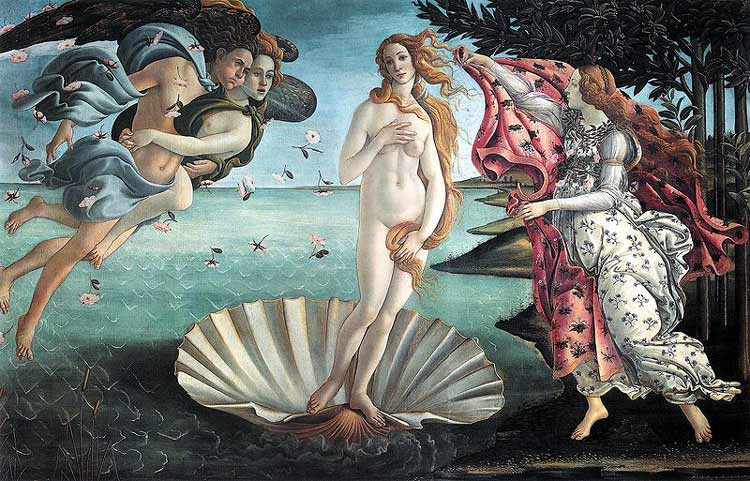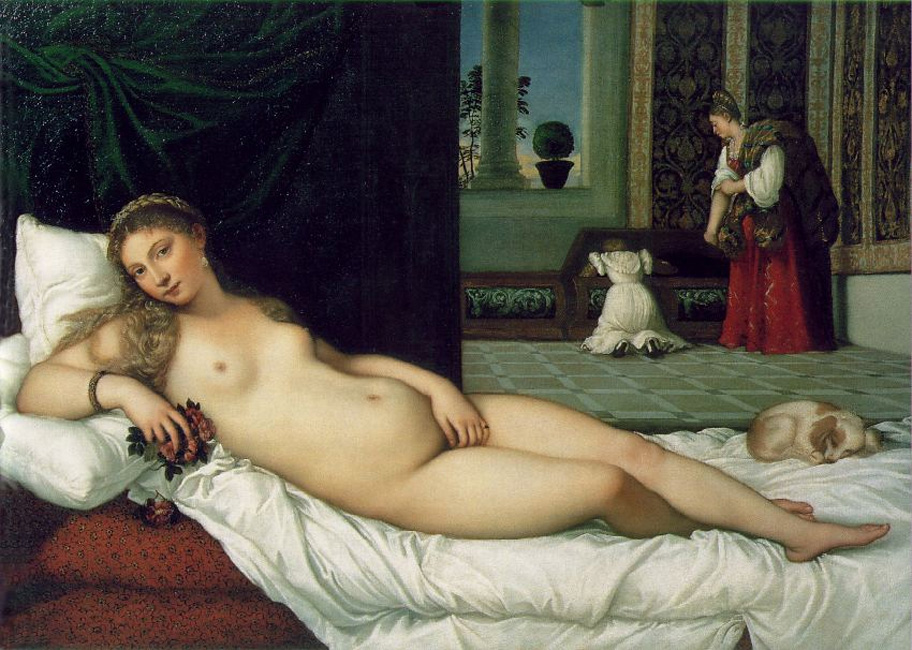In the beginning of the Early Renaissance different ideals start developing that directly affect how art is made. During the High Renaissance these ideals are perfected and can be seen within the art work. The Birth of Venus painted by Sandro Botticelli from the Early Renaissance illustrates the development of naturalism. Titian’s painting of the Venus of Urbino from the High Renaissance conveys naturalism at its best. The Renaissance ideas were focused around humanism. There were developing ideas in naturalism, idealism, and illusionism.
Painted in 1484-86 The Birth of Venus conveys Early Renaissance ideals. Color is used to bring a youthful and majestic feeling to the paint of the Birth of Venus. The colors are very bright and vibrant. The Venus’ hair is brightly painted to emphasis her modesty. Botticelli utilizes many colors throughout the painting. The garment which the devotee brought for the Venus is pink. The cloth covering Zephyr is a light blue color. Using many colors in a painting can convey naturalism because the natural world is full of color. There is use of line that in a way detracts from the naturalism of the painting. The way that the waves are depicted is far from how they appear in nature, which can clue the viewer that this painting was created during the Early Renaissance when paintings were picturesque. The Birth of Venus painting utilizes light and dark contrast. The Venus is illuminated and is very light due to her fair complexion. The areas around the Venus are darker, which helps emphasize the Venus. In the background of The Birth of Venus painting expresses illusionism. This is done by creating atmospheric perspective which means that the further into the background the more objects appear blue. The painting does this in a way that conveys the birth to be majestic. The texture of this painting suggests naturalism. The texture of the drapery in the clothing seems almost natural and conveys movement due to the wind from the ocean. There is movement from Zephyr swooping down causes his garments to be flowing. Zephyr’s and the nymph’s, Chloris, hair is being blown back from the force of him swooping. Venus’ and the devotee’s hair and clothing are also being blown from the ocean winds. The painting is well balance with Venus being the center, and the figures on her sides are asymmetrically balanced. Unity in this painting provides a harmony that is need. The Venus is born and the figures are coming together for her birth which conveys unity and harmony throughout the painting.
Titian painted Venus of Urbino in 1538 during the High Renaissance. This painting conveys developed ideas of naturalism, idealism and illusionism. Although Titian utilizes only a few colors, red, yellow and touches of green his painting feels very natural. The way that color is used in the painting of Urbino draws emphasis and guides the viewer. First one would see the red of the sheets that the Venus is laying upon then the viewer would see the red of the servant’s dress. The drapery behind the Venus is the only area of green, which gives a main emphasis on the Venus. The richness of the colors is overall visually pleasing. Unlike The Birth of Venus, there is not any unnecessary use of line. There is contrast within the painting that is with rich bold colors which contrast the light colors; this is different from The Birth of Venus that contrasts light and dark values. The bed Urbino lays shows a small area of red then contrasts it with the cream sheet. The same idea is applied with the red dress of the servant which contrasts the white dress the other servant is wearing. Texture within this painting is very natural with the way that the sheets are wrinkled from the Venus laying on them. The Venus’ hair is idealized yet appears very natural how it is laying over her shoulder. In the painting there appears to be minimal movement compared to The Birth of Venus. The Venus of Urbino suggests stillness; however there is movement in the background the servants are shuffling around putting the Venus’ clothes away. There is an illusion of perspective; the overall scene is inside the room yet there is an illusion of space by including a window where the viewer can see the sky and foliage. Unity in this painting is achieved by color. I feel that Titian used color carefully and precisely to tie everything together. There is not a true reason for why the servants are included yet Titian included them and unified the painting by using colors that were already present.
Titian achieved a more picturesque painting by utilizing ideals that have developed since the Early Renaissance that High Renaissance artists have perfected. Although both Venus paintings are beautiful works of art, Renaissance art is about naturalism, idealism and illusionism. Each painting can be identified to when they were creating during the Renaissance by how these ideals are refined.


Nice thoughts. Although there are also light and dark colors in Titian's painting, I think that they seem a little less stark because of his modeling (and even some chiaroscuro). Titian's female seems a little better integrated into the dark/light areas, which I think makes the contrasts less noticeable than Botticelli's example.
ReplyDelete-Prof. Bowen
Your post is really interesting. I love how a big part of your post deals with color. Though overall I have to say that I really liked how descriptive you got because it would let me see your second painting and the more I read the more I knew exactly what painting you were talking about.
ReplyDeleteJennifer Groce
interesting article.... Sharing an Interview with Leonardo da Vinci (imaginary) http://stenote.blogspot.com/2018/03/an-interview-with-leonardo.html
ReplyDelete